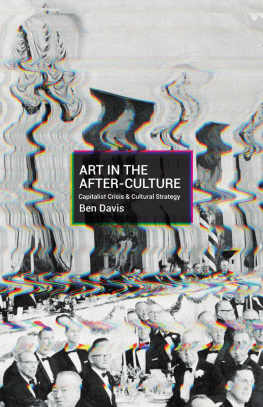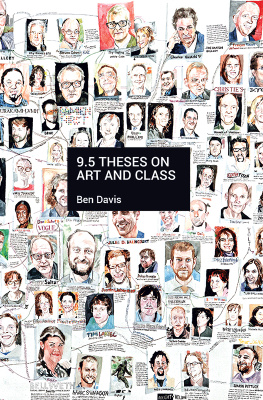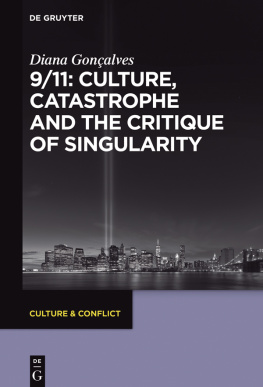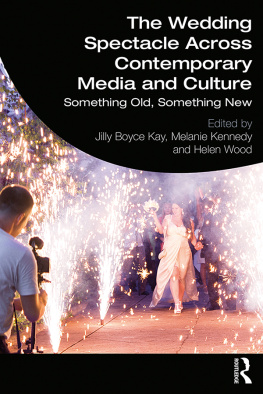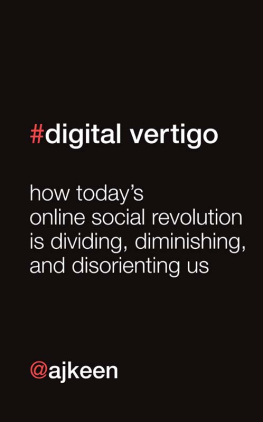Contents
Landmarks
Praise for Art in the After-Culture
Ben Davis understands that you cant truly understand art without an analysis of the economic system that created the artist. He understands that movements create change and that artists only create change if they are involved with that movement in other ways than being the expert observer. Heres to art criticism with an axe to grind.
Boots Riley
Ben Davis is the only art critic I read. These erudite and entertaining essays take the reader on a mind-bending tour through our fragmented, confounding, and commodified cultural landscape, providing welcome historical and political context to many of the high-profile controversies and existential challenges that define our age. Ever attuned to questions of power and profit, Davis never yields to cynicism or forecloses the possibility of creativitys role in our collective liberation. This kaleidoscopic collection will help you see and comprehend the world anewwhich is, in my book, what good art should do.
Astra Taylor
Amid the cultural sandstorm of infinite memes and ravenous engagement algorithms, rare sneakers and mythic NFTs, made-for-Instagram immersive installations and the relentless firehose of TikTok clips, Ben Davis asks a simple question: What about art? What follows is an indispensable series of provocations on the future of culture, politics, and society that speak to some of the most urgent issues facing societies where culture, capitalism, and identity have become nearly indistinguishable from one another. Following in the footsteps of theoriests like John Berger, Stuart Hall, and Lucy Lippard, Ben Davis is an essential guide to the politics of culture in the twenty-first century.
Trevor Paglen

For Chloe
2022 Ben Davis
Published in 2022 by
Haymarket Books
P.O. Box 180165
Chicago, IL 60618 773-583-7884
www.haymarketbooks.org
ISBN: 978-1-64259-483-6
Distributed to the trade in the US through Consortium Book Sales and Distribution (www.cbsd.com) and internationally through Ingram Publisher Services International (www.ingramcontent.com).
This book was published with the generous support of Lannan Foundation and Wallace Action Fund.
Special discounts are available for bulk purchases by organizations and institutions. Please email for more information.
Cover artwork Sara Cwynar, Men in Suits (Darkroom Manual), 2013. Courtesy the artist. Cover design by Josh On.
Printed in Canada by union labor.
Library of Congress Cataloging-in-Publication data is available.
10 9 8 7 6 5 4 3 2 1

PROLOGUE
Art in the After-Culture
The following is excerpted from a 2037 report of the Future Arts Alliance, originally entitled Three Mind-Melting Facts You NEED to Know about Contemporary Art.
Recent scholarship has come to speak of the after-culture, the mode of cultural production and consumption related to the new pattern of political and economic power that has consolidated in the wake of the last decades turbulence. Despite its continued contradictions, this new mode is now stable enough to analyze, and it seems clear that what used to be called visual art has today split into three distinct tendencies.
What media theorists and sociologists in the 2020s referred to as the aestheticization of capitalism is complete. Cultural life has largely migrated into various virtual platforms, all controlled by the Big Two technology corporations.
The market for new and singular art objects has cratered as interior decorating trends favor the ultra-minimalism that best serves as a background for various forms of customizable augmented reality experiences. Examples of old-fashioned object-based art created in artisanal traditions have been relegated to specialist historical research societies rather than public-facing institutions. Art in the Romantic sense of the expression of heroic individuality is largely understood to be anachronistic, a subject appreciated much the way ancient ruins or historical sites continue to be appreciated.
This artistic tradition is considered historically important, with the pathos of representing the life form of a superseded age of culturebut it is without a connection to continuing vernacular forms of creative expression.
Recent decades saw the attempt at self-transformation by museums to meet the demands of a presentist society. This has gradually come apart on the rocks of its contradictions. Art institutions oriented toward middle-class leisure consumption had a good run as purveyors of contemporary adult theme-park attractions, integrated into an increasingly fluid and mobile world of experience-based technological leisure. Practically, that meant sidelining questions of authorship in favor of the demands of interactivity from the second decade of the twenty-first century on. Deemphasizing who did something or the importance of personal or social symbolism expanded the audience for the museums with the resources to adapt, allowing institutions to focus directly on the demand for big-budget entertainment environments. The latest feat of maximalist installation by an artist became conceptually indistinguishable, in the eyes of the cultural consumer, from a pop-up environment wholly sponsored by a corporation as an advertisement. The result, however, was that there was little reason to think of the art experience as connecting with any historically special type of knowledge that was worth preserving.
This has left art institutions vulnerable to being seen as entirely irrelevant with the widespread introduction of neural aesthetic response production (NARP) technology, in its first years already close to universally embraced. Once the biological interface with artificial intelligence (AI) made it easy to directly plug into and stimulate the brain with personally tailored aesthetic experiences at low cost, there was no credible reason for most cultural consumers to want anything else. By eliminating the friction points to aesthetic delivery involved in an actually existing physical art space as a venue (which limits when and where art is available for experience), the direct stimulation of mental senses of beauty and meaningfulness made aesthetic experiences available to the widest possible audience. Such technology also minimizes the amount of unprofitable dead time: not only does mental customization of art experience avoid the problem of cultural consumers having to learn to assimilate an alien set of symbols from another person or culture before deciding whether they appreciate it or not, it also avoids the interruption of aesthetic experience involved in forcing consumers to reflect on what they would like to see or experience before they actually see or experience it. Outsourcing that decision to well-calibrated AI allows for maximum potential profitable aesthetic appreciation, a closed loop of pleasurable reward.
This is Tendency A.
We note, however, two additional tendencies, though all the strands of what used to be called visual or contemporary art define themselves against Tendency A, since the latter represents the fully capitalist, profit-oriented cultural mainstream of a capitalist, profit-oriented world.

